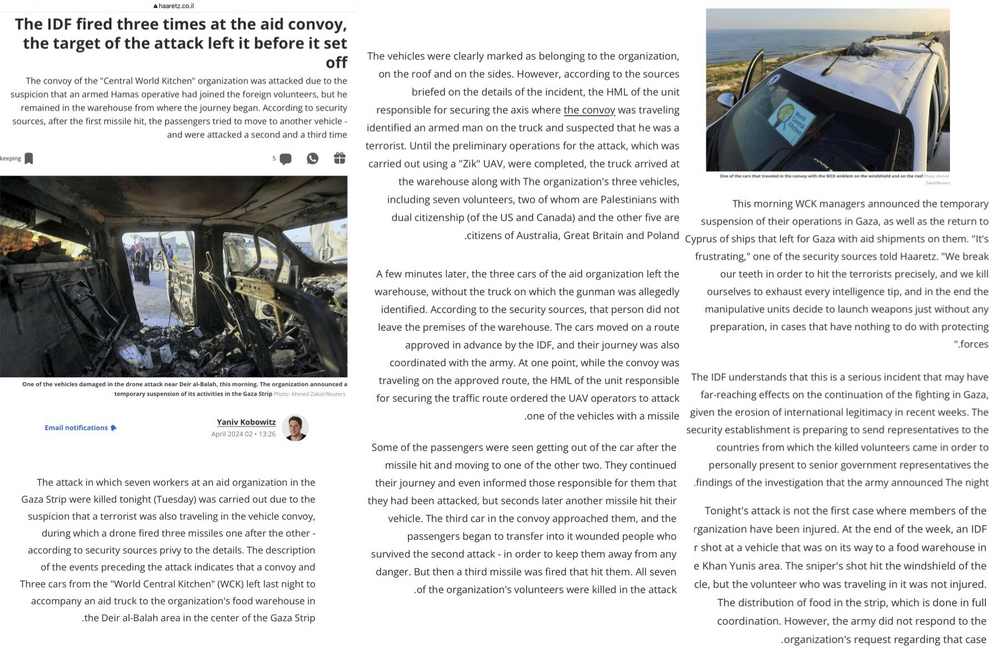-
Posts
28506 -
Joined
-
Days Won
8
Content Type
Profiles
Forums
Store
Downloads
Recruiting - 2020
2019-2020 Football Season
Football
Entertainment
Sports
News and Business
Cloak Room
Transfer Portal
Recruiting
Events
Posts posted by Anastasis
-
-
Israel
in Cloak Room
-
Seems relevant.
National Security Memorandum on Safeguards and Accountability With Respect to Transferred Defense Articles and Defense Services
-
3 hours ago, wildcat09 said:
It's very obviously not a fucking mistake. Jesus christ.
There is a fucking WCK sign on top of the vehicles. The route was approved in advance by the IDF. When they pulled the trigger (three times) they knew what they were aiming at. If they didn't, the level of incompetence is such that it's just one more reason we shouldn't be sending them weapons of war.
-
 3
3
-
 1
1
-
 1
1
-
-
Israel
in Cloak Room
3 minutes ago, MC Fresh Breath said:The transaction, which would amount to the largest US foreign military sale to Israel since the country went to war with Hamas on October 7, comes as the administration is also expected to notify Congress soon of a large new sale of precision-guided munitions kits to Israel, the people said.
You got to think that the outcry at this point should be enough to pressure the admin to stop these transfers, particularly of munitions. Right?
-
 1
1
-
-
Haaretz reporting three drone strikes, knocking out three vehicles in sequence as the aid workers fled from one to the other. The convoy was travelling on an approved route that had been coordinated with IDF. Israeli security sources say that they observed an armed individual travelling with the convoy earlier in the day, before the convoy stopped at their supply warehouse. The vehicle that was carrying the armed individual was not part of the convoy when it was struck. WCK suspending their Gaza operations, and the ship they had sailing from Cyprus with aid has turned around.
Here is a google translate image lifted from twatter.
-
 1
1
-
-
-
1 minute ago, ROFL BOX said:
SMS already in your phone.
Roger.
-
-
John Bolton is very concerned.
-
1 hour ago, fattyflattie said:
No shit. I’ve been hunting a good project cart for awhile now.
See few really cool vintage ones on bringatrailer every once in a while.
https://bringatrailer.com/go-kart/
-
2 minutes ago, burntorangebongos said:
I caught about bigger than pea size but not quite grape size hail for about a total of 7 minutes. What kind of damage do you think that did? Does anyone here know? My roof was replaced in 2016.
It moved through pretty quick. Wife's car took a few good dents.
-
@ROLFbox alert golf ball sized hail in lakeway/bee caves area.

-
 1
1
-
-
Check that. 19th century.
-
5 minutes ago, bolverk said:
I don't think he's right. I was raised Southern Baptist, and it was definitely taught
The IC is a doctrine related to original sin. The Catholics teach that Mary was conceived free of original sin. It doesn’t have anything to do with the virgin birth. It’s a doctrine that was formalized in the 20th century by the Catholic Church. It undermines an incarnational understanding of salvation and is based on a western understanding of original sin and for those reasons most orthodox reject it.
-
 2
2
-
-
-
 2
2
-
-
God became man so that man could become God. Happy ham Easter.
-
On 3/30/2024 at 8:34 PM, HenryJames said:
https://www.nature.com/articles/d41586-024-00902-2
Two things need to be said after reading The Anxious Generation. First, this book is going to sell a lot of copies, because Jonathan Haidt is telling a scary story about children’s development that many parents are primed to believe. Second, the book’s repeated suggestion that digital technologies are rewiring our children’s brains and causing an epidemic of mental illness is not supported by science. Worse, the bold proposal that social media is to blame might distract us from effectively responding to the real causes of the current mental-health crisis in young people.
Haidt's response. "Ironically" via social media.
QuoteA review in Nature, by
@candice_odgers
, asserts that I have mistaken correlation for causation and that “there is no evidence that using these platforms is rewiring children’s brains or driving an epidemic of mental illness.” Both of these assertions are untrue. https://nature.com/articles/d41586-024-00902-2…
@zachmrausch
and I have been collecting the published studies on both sides since 2019, organizing them, and making them available for public viewing and commenting, in multiple Google docs available here: https://anxiousgeneration.com/resources/collaborative-review-docs… In the “social media and mental health” doc, we currently list 22 experimental studies (16 of which found significant evidence of harm) and 9 quasi-experiments (8 of which found evidence of harm. Odgers cited only the 9th one.) We also examine the many meta-analyses and review papers. I lay out the evidence for causality (not just correlation) and walk the reader through the Google doc in this post at After Babel: https://afterbabel.com/p/social-media-mental-illness-epidemic… People really need to stop saying that the evidence is “just correlational.” Sure, there are a lot of correlational studies (79 in our Google doc, of which 64 found significant correlations with variables related to poor mental health.) But there are also many experiments supporting my claims of causation. I’ll write a post at http://Afterbabel.com in April responding more fully to the arguments of the skeptics (including Odgers). For now, I point interested readers to a post in which I laid out 6 problems with the way that the skeptics have conceptualized the debate: https://afterbabel.com/p/why-some-researchers-think-im-wrong… I just want to note two more problems with Odgers’ review. First: She says that I am offering a simplistic one-factor explanation: it’s social media! But I am not. My story is about two major factors (end of the play-based childhood, rise of the phone-based childhood), each of which has many components that bring a variety of harms to different children in different ways. My book is full of lists of causal pathways. There is no one causal pathway that, on its own, explains “the kind of large effects suggested by Haidt.” Yet when you add up all the different ways that the phone-based childhood is harming different kids, some of which we learned about in that Senate hearing on January 31, you end up with a lot of kids being harmed in many ways, and these many harms combined can easily explain the “large effects” even though most pathways affect only a subset of kids. Yet Odgers and the other skeptics focus intently on studies that operationalize social media in one crude way (total # of hours per day), and then correlate that number with some measure of anxiety, depression, or other mental ailment. When the correlations turn out to be around r = .15 for girls (which is actually a number we agree on, as I explain in the previous link), the skeptics conclude that this is not large enough--by itself--to explain the epidemic, so social media must be only a trivial contributor to the epidemic. This is an error caused by an overly narrow operationalization of a complex phenomenon: the radical transformation of daily life that happened for teens between 2010 and 2015. Only a sliver of the story is captured by the crude measure of “hours per day” on social media. The skeptics’ skepticism would be more compelling if they had an alternative explanation for the multi-national decline in mental health that happened in the early 2010s, but they do not. Odgers claims that the “real causes” of the crisis, from which my book “might distract us from effectively responding,” are the lingering effects of the 2008 Global Financial Crisis, which had lasting effects on “families in the bottom 20% of the income distribution,” who were “also growing up at the time of an opioid crisis, school shootings, and increasing unrest because of racial and sexual discrimination and violence.” I agree that those things are all bad for human development, but Odgers’ theory cannot explain why rates of anxiety and depression were generally flat in the 2000s and then suddenly shot upward roughly four years after the start of the Global Financial Crisis. Did life in America suddenly get that much worse during President Obama’s 2nd term, as the economy was steadily improving? Her theory also cannot explain why adolescent mental health collapsed in similar ways around the same time in Canada, the UK, Australia, and New Zealand, as Zach and I have shown: https://afterbabel.com/p/international-mental-illness-part-one… Nor can she explain why it also happened in the Nordic countries, which lack most of the social pathologies on Odgers’ list: https://afterbabel.com/p/international-mental-illness-part-two… Nor why it also happened in much of Western Europe: https://afterbabel.com/p/international-crisis-europe… Nor why suicide rates for Gen Z girls (but not alway boys) are at record levels across the Anglosphere: https://afterbabel.com/p/anglo-teen-suicide… I just can’t see a causal path by which America’s school shootings, lockdown drills, inequality, or racism caused girls in Australia to suddenly start self-harming or dying by suicide at the same time as American girls. In short: There is a great deal of evidence for my claims that something terrible is happening to teens in many countries, and that a major contributing factor is the sudden international arrival of the phone-based childhood. I lay out this evidence––with hundreds of footnotes––in chapters 1, 5, 6, and 7 of The Anxious Generation. I have also laid it out in many posts at http://AfterBabel.com. All along, Zach and I have “shown our work” in public Google Docs and Substack posts, and we have invited others to critique it. Zach has made supplemental files for every chapter in The Anxious Generation, which give links to the datasets and data points that he used to create the graphs in the book. We invite you to check our work: https://anxiousgeneration.com/resources/supplements-for-each-chapter… Our work has benefited from cordial, normal, academic debates with the skeptics. We will continue to welcome their critiques. But please, everyone, stop saying that the evidence is “just correlational.”
-
Bathrooms aren’t hard. Pinch one off in any Nordic country. They got it figured out.
-
24 minutes ago, Brisketexan said:
And leftover rice stirred together with leftover enchilada gravy and cheese is its own beautiful gift from the heavens.
Damn.
-
 1
1
-
-
10 minutes ago, Bevo said:
That's the way I feel about all the Hamas leaders and the Iranian enablers.
Good. Six of one, half dozen the other.
-
Just now, dcbc said:
Soon. It's in the oven reheating now.
Interested to see if it holds together or just kinda collapses. The filling looks pretty wet in the middle.
-
 1
1
-
-
Hopefully the hernia is in his aorta.
-
13 minutes ago, 4th&Five said:
And republicans.
They’re the worst. Basket all the former ones with residual brain damage in to be comprehensive.
-
11 hours ago, jimmyjazz said:
I'd like someone to explain how this is openly hostile to Christians in the first place?
It's not. Nobody cares about any of this stuff outside of very online social media brain damaged folks.
-
 1
1
-
 1
1
-





Israel
in Cloak Room
Posted
Watching some clips from today of Kirby, the pentagon spokeswoman, and the state department spokespeople. Clowns and/or sociopaths. Keep your options open. Example given: